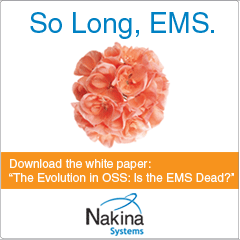|
|

By Wedge Greene and Barbara Lancaster
Convergence & crossover
Once upon a time, Telecom was iconoclastic – keeping to itself and inventing everything it needed to perform its mission. Huge labs like Bellcore and Ipswitch Labs advanced human ingenuity. Telecom developed distinct standards and unique tools.
The rise and pervasive reach of the internet and of business-specific media broadcasting is making business and technical information readily available to interested parties in any industry. This leads to a transfer of knowledge across vertical industrial lines of how different companies use tools to solve problems. Also the prevalence of mergers and acquisitions and the emergence of the successful executive as a sought after “free agent,” means that executives are crossing vertical market lines with some degree of regularity. When a tool or process worked for an executive before, they try to replicate their success by bringing the same solution to their new environment. A surprising number of these “experiments” work.
It is natural that some of the first “omni” tools were those that supported general business activities. The ERP (Enterprise Resource Planning) and CRM (Customer Relationship management) product revolutions are prime examples. They were developed outside of the traditional telecom ecosystem. However, there is nothing industry-specific about these product types and they have developed strong user groups inside telecom.
On the technical convergence side, the generalization of services and tools is a strong trend which will continue throughout the next decade. It is supporting the extension of general business services into more specialized business activities unique to each industry. Customer Relationship Management had to do with maintaining a constant and centralized data record of customers. The emergence of Service Oriented Architecture (SOA) in programming has made the modern CRM data record easily accessible by all service programs that need to know about customer vitals and history. The more information on customer interactions that makes it into the common CRM repository, the better the decisions reached using CRM systems can be. So it is reasonable to extend the “reach” of CRM into the corporate systems which actually interact with the customer. A principal avenue of interaction is still the Call Center. First contact provides the greatest insight into what customers think and do. But to learn from this knowledge, we need to advance the model of services and the supporting technology to bring the Call Center into the 21st century. Let’s look at the two models most prevalent today: The Call Center as the single point of contact, and the Help Desk, direct contact between the customer and the problem solver.
The Call Center: traditional separation
The call center was developed in the telecom ecosystem but has found application in all industry groups. The call center arose in telecommunications in the 1920’s and was used internally for customer service until the late 1960’s. The call center was originally designed to intercept/accept incoming calls and handle all customer questions, requests for service, and complaints.
Call centers were so efficient that very soon after the introduction of schedule D “800” call services, call centers became a primary telecom service for other industry groups. The service models also transited with the technology.
|
|
"...the generalization of services and tools is a strong trend which will continue throughout the next decade." |
|

Processes and systems deliberately separated the roles of interacting with customers (the external world), from acting on customer requests (the internal world). Specifically, call centers were built and staffed highly trained customer service representatives who could handle a wide range of requests and complaints, creating a real “single point of contact.” This meant that customers didn’t need to search for the right department and right phone number to call. It also meant that operations people were insulated from customer “interruptions.” The model was clear: call centers were staffed with people-skilled personnel and operations groups, like NOCs, were staffed with technicians and engineers. Call centers used different tools than Operations.

Call centers exploded into other industries and developed sophisticated call queuing systems (the first ACD was invented for call centers by an aviation supplier) to hold calls until an operator was available. When coupled to bad policies, this lead to a practice of the long wait in queue which in turn lead to extremely bad press for the airline industry – and just about every industry for a while. Policies changed to staff call centers with a multitude of responsive agents, often with specialized skills. Eventually this evolved to skills-based targeted routing to efficiently select and pass a call to the appropriate call center agent. Customers could expect shorter queue times and an expert response to their question.
However, in the case of technical service issues, the “middle man” approach kept the customer away from the NOC technician working on solving the problem. Time to repair was heavily dependent on the accuracy of the information captured by the agent on the trouble ticket sent to the NOC. Information and data were often confused. Many efforts were applied in the 1980s and 1990s to correct this information gap. Also, many corporate customers had their own telecommunications departments, and their own internal single point of contact for their employees. This added another degree of separation between the user experiencing the problem and the NOC technician attempting to fix it. Customer service representatives however remained the single point of contact, which lead eventually to the huge outsourcing industry we have today. Born from the telecommunications industry, the only link today with telecommunications is the need for connectivity.
article page | 1 | 2 | 3 | 4 | 5 |
|
|
|
 |
 |
|




